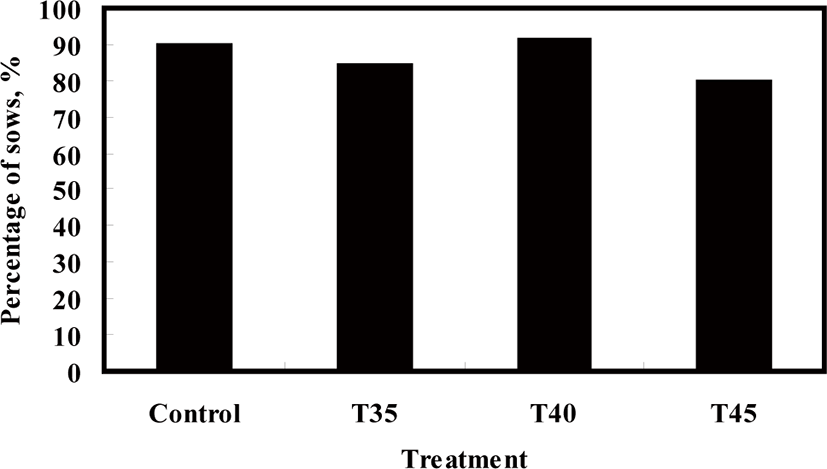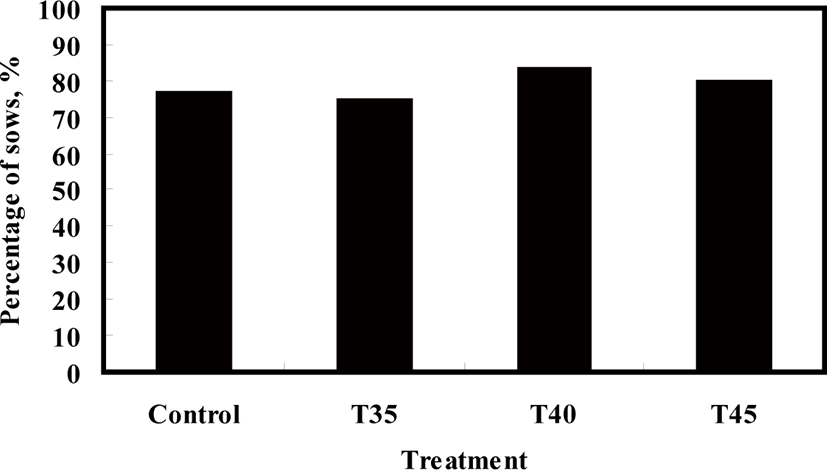INTRODUCTION
A high piglet weaning weight is important because there is a strong positive relationship between the weaning weight and post-weaning growth of piglets. Heavier piglet weaning weight requires fewer days to reach 105 kg more than lighter-counterparts [1]. This can contribute to the feed conversion.
Suckling piglets respond to grunting of their own sow or unfamiliar sows [2]. Jeon et al. [3] reported that playing an artificial nursing and suckling call effectively induced nursing behavior in sows and suckling behavior in piglets. In addition, Cronin et al. [4] reported that piglet growth was improved by playing the grunting call. This response of sows and piglets to the artificial nursing grunt stimulus may result in an increased piglet weaning weight.
Crushing by sows is a major cause of piglet death [5,6]. If an artificial nursing sound stimulus can reduce unsuccessful piglet suckling, it may also reduce crushing of piglets by sows. In sows, the average interval from weaning to estrus is about five days, but this can vary considerably with temperature, nutrition, social stress, illness [7], lactation length [8,9], and number of suckling piglets [10]. Since the number of suckling piglets (suckling intensity) is one such factor, a nursing sound stimulus during the lactation period may affect the sow weaning to estrus interval.
This study was conducted to determine an effective interval of playing a nursing sound stimulus.
MATERIALS AND METHODS
One hundred forty four lactating multiparous sows (Landrace × Yorkshire; parity range: 2 to 7) and their litters ((Landrace × Yorkshire) × Duroc) were housed in farrowing crates (210 × 60 cm) located in pens (240 × 160 cm) within four compartments (one per treatment) of a windowless building. Fans provided a maximum ventilation rate of 14.655 cmm / sow & litter [11]. An infrared lamp (250 W) was installed above each creep area. It was turned on when temperature in the farrowing was below 29°C during the experimental period.
All sows were moved into the experimental farrowing house approximately seven days prior to farrowing and were fed a standard ration of commercial concentrate twice a day (Table 1), at 07:00 and 18:00 h. They had free access to water throughout the study. Piglets were cross fostered before they were 24 h old.
1) Composition per kg of mix: vitamin A, 2,750,000 IU; vitamin D3, 220,000 IU; riboflavin 1,450 mg; d-pantothenic acid, 11,000 mg; niacin, 11,000 mg; choline, 110,000 mg; vitamin B12, 11 mg; menadione, 1,100 mg; ethoxyquin, 2.2 g; vitamin E, 11,000 IU; contained 20% Zn, 10% Fe, 5.5% Mn, 1.1% Cu, 0.15% I.
All piglets had their teeth clipped and tail docked at 1 day of postpartum, the male piglets were castrated at 3 days old, and they were conventionally supplied with creep feed after ten days of age [12; Table 2].
1) Composition per kg of premix: vitamin A, 1,760,000 IU; vitamin D3, 176,000 IU; riboflavin, 1,760 mg; d-pantothenic acid, 8,800 mg; niacin, 8,800 mg; choline chloride, 195,800 mg; vitamin B12, 8.8 mg; menadione, 200 mg; d-biotin, 176 mg; vitamin E, 4,400 IU; Contained 15% Zn, 17.5% Fe, 6% Mn, 1.75% Cu, 2% I.
The call of nursing and suckling, plus a click [3], was used as a nursing sound stimulus. The nursing and grunting sound were recorded with microphone and camcorder in the farrowing room. Sound editing and digitalizing were done by using Cooledit Pro (Syntrillium software, 2003).
Tanaka et al. [13] reported that the sow’s grunting was about 75 dB, therefore, the call stimulus was played by using a computer and speaker which were set at an average of 75 dB. A sow’s glands get filled with milk 35 min after the last milk has been released [14,15]. According to Bøe [16] and Jensen et al. [14], nursing frequencies of individual sows during the first week of lactation vary from 30 to 70 min. Hartman et al. [17] reported that an average nursing interval was about 52 min, while according to Götz [18], nursing intervals over four weeks varied from 35 to 41 min.
Based on these data, the stimulus call was played at intervals of 35 min (T35), 40 min (T40) and 45 min (T45). The sows and their litters were divided into 3 blocks (n = 48 each). Sows and their litters within each block were randomly assigned to one of the four treatment groups including the control which had no call stimulus (n = 12 each). The call stimulus was played to the experimental group immediately after its first parturition, and it was continuously played until the day of weaning. The piglet weaning age was twenty-one days. The computer program written in Labwindows/CVI (National Instruments, Austin, Tex., USA) language was used to play the nursing sound according to schedule.
The feed intake of all sows, and creep feed intake of all litters were calculated based on the difference between the feed allowance and leftover food.
The back fat thickness of each sow was measured ultrasonically (Aloka SSD-500V, USA) before farrowing and at weaning stage at the level of the last rib and 65 mm from the dorsal midline [19,20].
The number of crushed piglets was recorded every day, and estrus detection was carried out every 12 h after 3 days of weaning until the end of estrus. Occurrence of estrus was defined according to the standing reflex in front of a boar and through the reddening and swelling of vulva.
Litter weight and litter size were recorded on the day of birth (d 0) after cross-fostering, and on day 21 (weaning).
Out of the 144 sows and their litters, four sows and their litters were excluded because of its problems with mammary glands. Some piglets were also excluded because of stillbirth, disease, non-viability, or a birth weight of 800 g or less [21]. All data with the exception of crushing piglets, estrus interval, feed intake and creep feed intake were statistically analyzed using the SAS GLM procedure (SAS Inst. Inc., Cary, NC, USA). Post hoc analysis was conducted by using Duncan’s multiple comparison test.
Chi-square analysis [22] was used to determine significant differences in percentage of sows not crushing piglets, and the sows returning to estrus within 5 days after weaning because most sows come into estrus within 5 days following weaning [21]. The feed intake of the sows and the creep feed intake of piglets were analyzed with the repeated measures ANOVA (SAS Inst. Inc., Cary, NC, USA).
RESULTS AND DISCUSSION
No difference was found in parity and feed intake of sows among treatment groups (p > 0.05; Table 3). The loss of back fat thickness in sows was not different among treatment groups (p > 0.05; Table 3). According to Pluske et al. [23], feed intake affects back fat thickness. Since there was no evident difference in feed intake, there was no difference in back fat thickness loss among treatments. Unfortunately, BW of sows was not measured in this study, but we assumed that BW loss of sows was not different among treatments because the feed intake and the back fat thickness loss were not different among the treatment groups.
There was no difference in litter size, creep feed intake, and birth weight among treatments (p > 0.05; Table 3). Average weaning weight and average daily weight gain of piglets in T35 and T40 groups were greater than in the control group (p < 0.01; Table 3), but the T45 group did not differ from the control group (p > 0.05; Table 3).
According to Walser [24], suckling piglets respond to nursing calls of their own sow or to unfamiliar sows. Therefore, piglet suckling behavior may be induced by a nursing sound stimulus. King et al. [25] reported that the sow milk output at 35, 70, and 100 min after the last nursing period did not differ from output of after 50 min. Spinka et al. [15] also reported that sows were able to produce almost a full ration of milk at 35 min after the last milk release, and to release milk at intervals of 40 min or less for a relatively long period of time. Castren et al. [26] observed that sows stabilize after eight days postpartum, and nurse in about every 40 min. Based on these previous studies, it is believed that the nursing grunt stimulus might induce piglets in the T35 and T40 groups to suckle more frequently, resulting in greater daily weight gain, compared to the T45 and control groups. However, Bate et al. [27] reported that growth rate in suckling piglets increased when a nursing call stimulus was played every 47 or 57 min, but not in the interval of 37 min. It was not clear why the results of this study differed from those of Bate et al. [27]. Hence, we suggest that the nursing grunt stimulus may provide positive effect on the weight gain of piglets, but more studies are needed to find the exact effects of grunt stimulus.
No difference was detected among treatments in the percentages of sows returning to estrus within 5 days after weaning (p > 0.05; Fig. 1) and sows without crushed piglets (p > 0.05; Fig. 2). The weaning to estrus interval can be affected by the lactation length [9,8], parity [28], litter size [10], and ambient temperature [29]. In this experiment, all above mentioned factors were controlled in all groups, therefore it seems that the call stimulus during lactation had no effect on the sow weaning to estrus interval.


In suckling piglets, 5.2% died because of traumatic injury. Most of these were crushed by sows [6]. When piglets starve due to failure in suckling, they are highly likely to be crushed by their sows [5,30]. Sow milk production affects piglet growth [31], and that heavier piglets are less likely to be crushed by their sows [32]. Sow grunting is an important factor in milk release [33], because it synchronizes the piglet-suckling behavior [2,34,35]. Based on this information, it appears that crushing of suckling piglets by sows may be reduced in the nursing sound stimulus groups, through promotion of suckling behavior synchronization and increases successful suckling. However, there was no difference in the percentage of sows without crushed piglets among treatments.
In conclusion, the nursing sound stimulus did not affect sow performance, but it improved the performance of suckling piglets; the T40 group had the greatest average daily weight gain. These results suggest that the effective interval of the nursing sound stimulus should be near 35 or 40 min to improve the performance of suckling piglets.
















